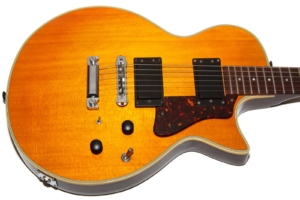
This isn’t really a model that I lusted after so there’s no cool story about me wanting one since I was born (20 years before the guitar was even made). Nope – I bought this one just to write it up, so lets see if it’s worthy of the Guild Nightbird name by evaluating all its details in a completely impartial and unbiased way. Well, as impartial as unbiased as an unabashed Guild fanboy can be.
Introduction
Yes, there are a lot of variations on the Nightbird theme, and I’ve covered those differences in my GAD’s Guide to Guild Nightbirds article.
This guitar is a Nightbird I which means it’s got a spruce top, no neck or headstock binding, a rosewood fretboard, and chromed hardware. This guitar also has Dimarzio pickups which is a departure from most other Nightbirds, or at least the high-end Nightbirds that people usually associate with the Nightbird name.
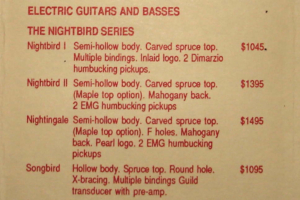
While the lack of bling was fine from a cost-savings point of view, a couple of the feature changes made a pretty dramatic difference when comparing the Nightbird I to a Nightbird II or original Nightbird. Let’s take a look.
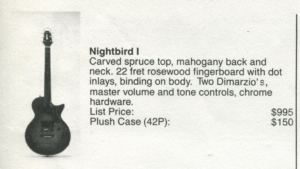
The other big difference is the pickups, and though I’ve never been a big fan of putting EMGs in Nightbirds, the Kent Armstrong pickups in the original Nightbird GG aren’t too shabby and the Guild HB1s are some damn fine pickups. Guild eschewed all of those choices on this guitar and instead put in passive Dimarzios. That’s not necessarily a bad thing, but it changes what it means to be a Nightbird at a certain level.
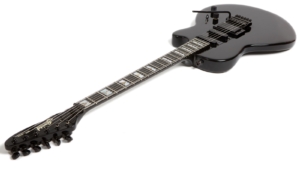
Put in a way that would likely annoy Guild fans, the Nightbird I was the least expensive Les Paul type Guild you could buy in 1987.
Finish
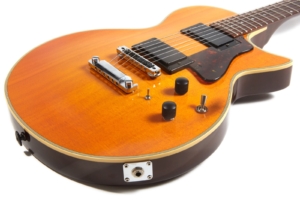
The finish is very well done as it is on all Guilds from the Westerly plant, and the amber coloring over the spruce top is quite nice and also pretty iconic when it comes to spruce-topped Nightbirds. There’s really not much else to say because there are no problems to be found which is kind of amazing given the fact that the original case I got this guitar in is a bit of a (fully functional and protective) mess.
Fretboard and Neck
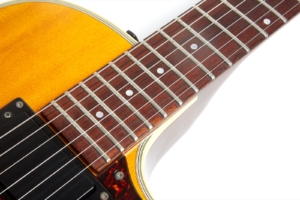
The fretboard is fairly wide at just a bit over 1 11/16″ at the nut and feels great all the way up the neck, though if I’m being honest I really miss the neck binding as a result of playing my other Nightbirds. That’s obviously a personal thing and also a bit of an elitist observation so understand that if you’re not used to playing other Nightbirds that this is not a problem in any way – it’s just different than most of the guitars that share the Nightbird name.
The fretboard is rosewood and the neck is one-piece mahogany. The frets measure at .028″ high by .106″ wide making these pretty typical Guild frets and not the jumbos found on the Setzer Bluesbird from the same year.
The fretboard is a fairly flat 12″ without being crazy flat like a shredder. I tend to like the 12-14″ radiused boards because I think they’re a nice compromise between too rounded (7.5″) and too flat (20″), though given the choice I’ll personally opt for flatter over more curved, likely because of my history playing in the ’80s when Super Strats were all the rage.
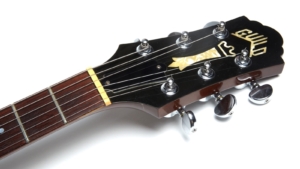
Build Quality
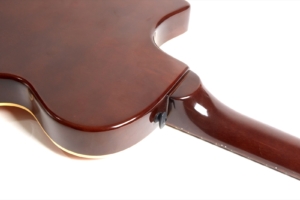
The neck joint is beautiful and rock solid and this feels like a quality guitar in every way. I do find it interesting that though this guitar is a “low level” Nightbird that it still has 9-layer binding on the body. This makes me wonder if the same body is used on both the Nightbird I and spruce-topped II while the necks and hardware are upgraded for the II. This would make sense from a manufacturing standpoint, but that’s pure speculation on my end so don’t take it as truth unless you hear it from Hans Moust.
I should also point out that though I tend to refer to this is the low-end Nightbird that it still feels better than just about any Gibson below the $2000 price point out there today, at least to my judgmental hands. I do prefer a nice neck binding, though. Did I mention that already? I think I did.
This particular guitar weighs 7 lbs 11 oz (3.49 kg) which is light for a guitar of this style, but not particularly light for a chambered guitar of this ilk. Hell, I had an Historic Les Paul that was solid and weighed only six ounces more but that’s not really a comparison that means much of anything since that was a $4000 guitar on the used market. That guitar was a magnificent 2004 Gibson Historic R9 if you’re wondering and it was a fabulous guitar, though I sold it and bought two Nightbirds with the proceeds.
Pickups
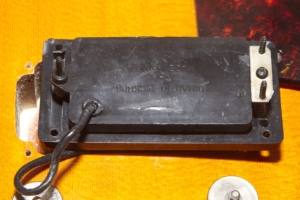
I emailed Dimarzio about the pickups and the response what that the bridge pickup (shown to the right) is likely the original version of the Super 2 (DP104) though the cover on that model has 12 holes. My theory is that Guild changed the cover or ordered them with different covers to fit into the Nightbird esthetic. Sadly, if there were any additional markings or labels they are long gone. I look forward to Hans’ next book when mysteries like this will probably be solved.
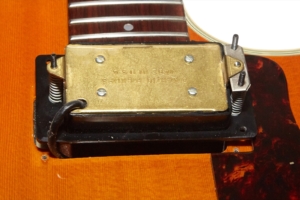
Electronics
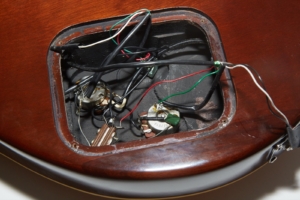
Although the wiring is messy, there’s nothing terribly exciting about it aside from a minor quirk that the selector switch is wired to both the master volume and tone whereas I expected it to be wired to the volume pot and that then wired to the tone pot. The difference in what I just described is irrelevant since this is an AC circuit but I noticed it because it was different than what I’m used to seeing. It’s interesting but I doubt it’s important.
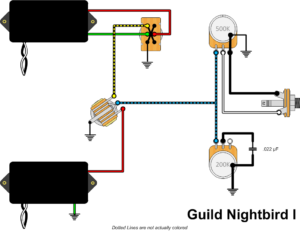
Hardware
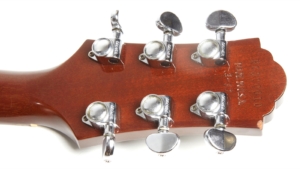
The strap pegs are the oddly shaped Gripper type and if you ever break yours (I’ve broken two over the years) you can get replacements at StewMac here. Thanks to whomever it was on the Let’s Talk Guild forum who pointed that out to me. Sadly I’ve forgotten who you were.
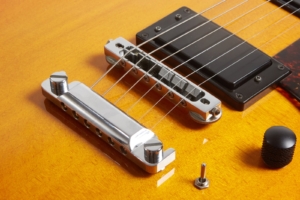
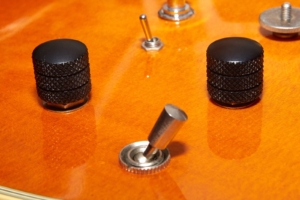
The switch tip on the pickup selector is also hard to replace as that slightly domed top is a a bit of a Guild-specific feature. If you see a rounded top like on every other guitar on the planet, it’s been replaced with a modern part.
Sound
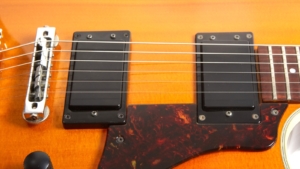
The semi-hollow body design imparts a bit of an ES-335/Starfire tone to the guitar and the phase switch certainly adds some variety to the guitar, though only if your’e fan of the nasally Peter Green out-of-phase tone. But aside from those obvious design points, what really separates the guitar from most similarly shaped guitars is the spruce top.
ODS100 Clean
Open Chords #1
Open Chords #2
7th Chords
JCM-800
A Barre Chords
D-Shape
Riff
Citrus
D-Shape Chords
As usual, for these recordings I used my normal Axe-FX II XL+ setup through the QSC K12 speaker recorded direct into my Macbook Pro using Audacity. I recorded using the ODS100 Clean patch, as well as the JCM-800 and one through a setting called Citrus which is a replication of the Orange Rockverb 50 and has become the “I wish it was still the ’80s” setting I like so much.
For each recording I cycle through the neck pickup, both pickups, both pickups with phase reversed on the neck, and finally the bridge pickup. All knobs on the guitar are on 10 at all times.
This guitar does pretty well and it doesn’t disappoint, but I’m not sure that it inspires me, either. To be fair, I’m quite spoiled because I own some seriously nice guitars, but I also have some very inexpensive guitars that blow me away. This one doesn’t seem to do that even though it has a cool vibe. I think I would be tempted to swap out the pickups in this guitar for something with a bit more chime. If it came with original Guild HB1s I think it would be a tone monster but the Dimarzios don’t seem like a great choice to me, or to be more specific, they don’t seem like a great choice to me based on my many decades of learned biases. Just because it doesn’t sound the way I want it to doesn’t mean anything to someone who loves the tone.
Playability
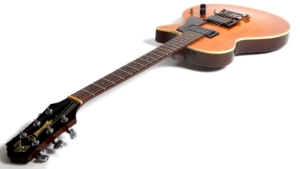
This guitar does have very nice sustain, and there are no real complaints otherwise, but for me the neck just doesn’t feel like other Nightbirds and that will forever be a distraction for me. This guitar, though, was not designed for me; it was designed for someone who wants the Nightbird experience without the high price. To that end, I’d say the guitar is a success.
Conclusion
I like this guitar, but I don’t love it. I can’t get past the impression that this is a cheaper neck slapped onto a high-end body and it just looks unbalanced to me. Having played many Nightbirds, it also feels unbalanced, but only in an esthetic sense – not in a physical sense (it balances fine while sitting and standing).
My complaint about this guitar must be taken from the point of view of a collector with access to too many very nice Guilds, some of which are magnificent Nightbirds. If you are unable or unwilling to spend the money that a Nightbird GG, II, or Custom commands, then this could be a great option.
Would I recommend this guitar? That depends on what you’re after. If you want the full Nightbird experience, then no – wait for a GG, II, or Custom. If you want most of the tone and don’t care about the bling, then yes, this is a great guitar. If you happen upon one of these in a pawn shop or on the Internet for a good price? Hell yes! This is a Guild after all, and that means it’s a damn fine guitar.
Donate: PayPal Crypto:
ETH: 0x0AC57f8e0A49dc06Ed4f7926d169342ec4FCd461
Doge: DFWpLqMr6QF67t4wRzvTtNd8UDwjGTQBGs

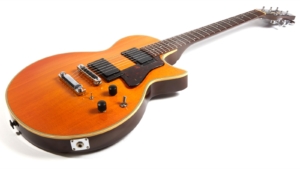

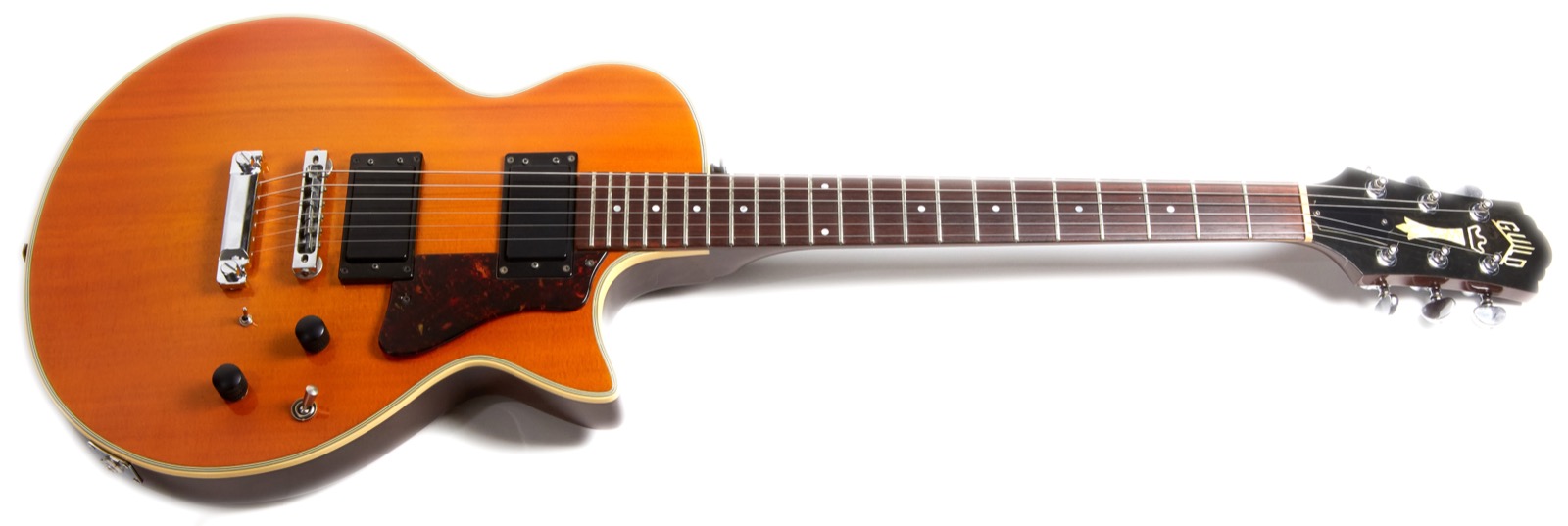
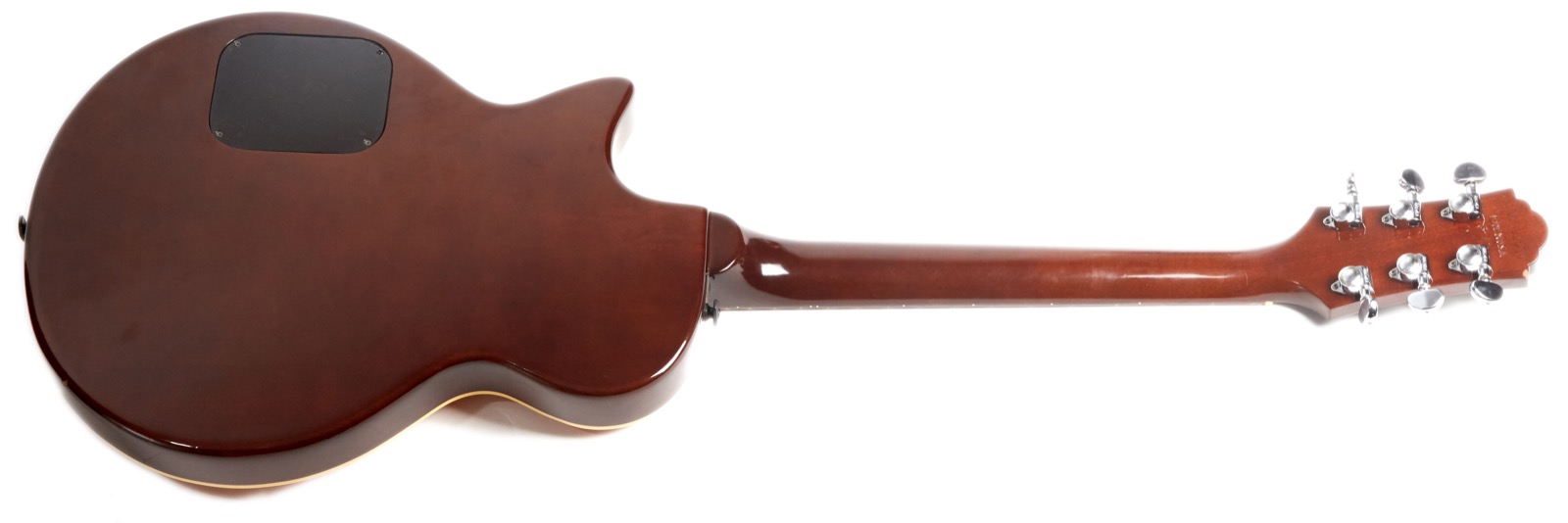
I had one of these guitar brand new as a teen and sold it within the last 8 years or so. In the last couple of years I’ve been looking for that exact guitar to try and buy it back, but the only problem is, I don’t have any info on the guy that bought it from me. I just know he was a local musician in the Boston area. The guitar in this pic looks exactly like mine(chips and all) and the date of manufacture is the same though I’m not sure about the serial number. Do you mind telling me where you acquired this guitar and if it turns out to be the one I owned, would you be willing to sell it back to me? Feel free to contact me either way. Thank you,
James Ryan
Hey there. Sorry, but I recently sold it at LetsTalkGuild.com
If you’d like I can forward your email to the buyer.
Yes that would be great if you could do that. Marshall2550@gmail.com. Would you mind if I asked where you got it from? Was it somewhere in the Boston area?
I’ve forwarded on your information.
Sadly, I don’t know where it came from. I bought it on eBay and the auction info is no longer available.
Thanks for your help. Much appreciated!
Sorry, James. I now own the Nightbird I, and it fits my hands too well. It’s staying in the collection for the foreseeable future.
Thank you for getting back to me. If you ever decide to sell it would you mind reaching out to me? Like I said, I’m not totally sure that it’s the same one that I owned but there were some chips on mine that would identify for sure. Enjoy the guitar. They are surely underrated, and make some beautiful sounds.
Are you enjoying the Nightbird? Do you mind if I sporadically stay in touch? Selling my Guild is one of my moments of regret but if I know where it is and that it’s well loved that’s a huge relief.
Got very lucky today. Bought an 86 GG. It is beautiful and very well cared for. Almost mint… AWESUM INSTRUMENT …..
What was the dimensions of the body, is it the same as Les Paul?
I no longer have this guitar and didn’t measure that when I did. I can tell you as an owner of both that they play very similarly with the obvious difference of the build and the neck. I have a Nightbird II I could measure if you’d like.
Bought one ( Guild nightbird 2 ) this year and love it. Mine is 1989 and in mint condition incl original case.
I’ve got a Nightbird with a case that’s in bad shape, any recommendations on a replacement case?
I have a Guild Nightbird with serial number BC100085 and th date 12-87 on the head stock. My guitar has pick-ups with the Guild name on top. I presume this are the Guild HB-1 pickups. Until now I did not open the pick-up cavatys to look at the bottom of the pick-ups. My guitar also have Gotoh Waffleback tuners instead of the Grovers. For the rest the parts are as you mention it on your test report.
Nice to have so much information about this guitar, even the store where I bought this guitar second hand did not know it was a Nightbird, they thought is was a Bluesbird.
If the pickups have black covers they’re not HB1s, but likely Dimarzios, assuming they’re stock.
Thank you for the information! I have had a Nightbird I for many years and often wondered about the differences between it and it’s fancier cousins. I hardly ever play it, but when I acquired it by chance I was amazed at the tone the guitar produces.